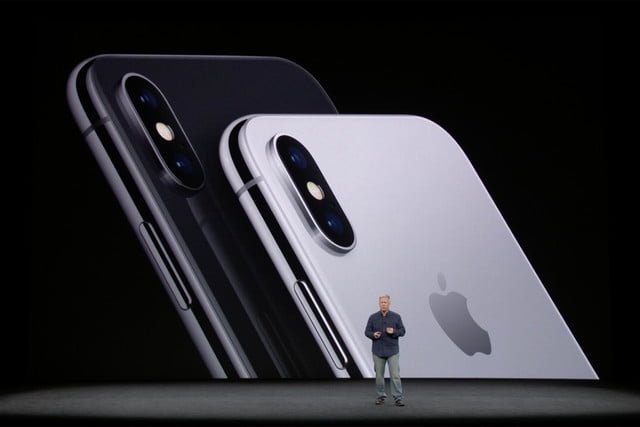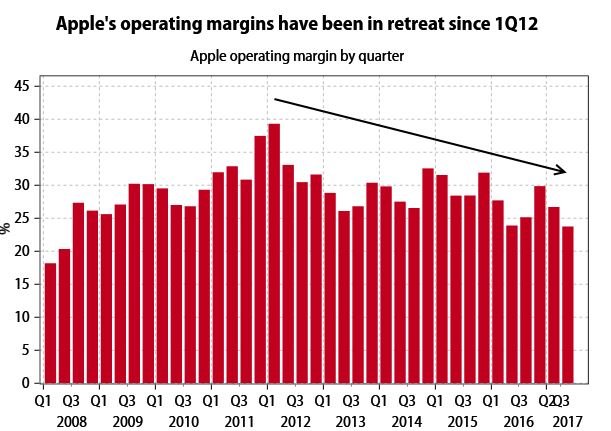Power Moving from Californian Tech to Asian Hardware Makers 🖥 📱
When Apple launched its new lineup of smartphones a couple of days ago, the loudest cheer may have come not from its new donut ring headquarters in Cupertino, but the factory lands of Taiwan and Korea that house its key component suppliers.

Launching a flagship phone whose innards are in short supply represents a subtle shift in power from software engineers in California to hardware makers in Asia.
Like many other endeavors, the smartphone market operates according to the Pareto 80/20 rule. Apple made up less than 20% of global smartphone shipments in 2016, but earned 80% of the sector’s profits. Its success has stemmed not by always offering the newest specs, but delivering a seamless user experience by integrating high quality hardware into an exclusive operating system. In short, it sells software-differentiated hardware.
Apple’s skill has been to sell softwaredifferentiated hardware...
That was the story until Apple launched its anniversary iPhone on Tuesday supporting an OLED screen, wireless charging and new smart cameras whose unit cost has reportedly risen from US$36 to US$48. These components are in high demand, but short supply, which may explain why Apple priced its phone so high and will delay its shipment until November.
...this time it is being forced to adopt the latest hardware, but at a high price
Apple’s operating margins have been on the slide for five years and the following factors explain why this may continue:
- Samsung is in effect the sole supplier for small OLED screens, which allow the display to be sharper and have curved edges—these screens cost Apple US$125 versus US$50 for LCD versions. Apple generally avoids relying on a single supplier, but given Samsung’s dominance in this segment, and Apple’s need not to fall behind, it had little choice.
- Apple is marketing its new phone on hardware differentiation and its US$999 price tag in part reflects the high cost of new components that allows the phone to deploy facial recognition as a security measure.
- Technology firms love to develop services as they can be expanded with little additional cost. At Apple, hardware sales growth still exceeds that of its electronic store, cloud operations and payment services.
The decline of software as an iPhone differentiator is shown by weak sales growth in China, where one app—WeChat run by Tencent—dominates the market. WeChat is an integrated social network and payment system that lets users check in for flights, book doctor’s appointments and hail a cab. Since it works the same on all operating systems, consumers have been ditching Apple for cheaper phones made by Huawei, Vivo, Oppo, and Xiaomi.

In China a smartphone’s operating system is not a key factor for consumers
Apple is seeking to reinvigorate its overall proposition with augmented reality apps, and has launched a platform for third party developers. Its familiar chicken-and-egg challenge is to get consumers to use and pay for AR apps, so that software firms are incentivized to develop them. This will no doubt happen, but perhaps not quickly.
Even if demand for new high-end phones is not game-changing, the higher cost of components will deliver a boost to Korea and Taiwan
That’s why this cycle should favor Asian hardware suppliers, especially those that have broken out of the commodity trap and are operating in segments which are technically demanding and face supply constraints.
I remain skeptical that recent product launches will spur a mass replacement cycle at the high end of the market. Still, even if demand ends up being middling, the bigger piece of the pie going to Asian suppliers will benefit economies such as Korea and Taiwan. South Korea’s information and communication technology exports hit a record high last month, mostly driven by smartphones and smartphone parts, which account for 37% of Korea’s total exports which totaled US$47bn in the period.
Source Image: 1

good reviews why the price of apple smartphones is expensive. This is very good news that the Korean and taiwan economies are also growing.
thanks for sharing @ vlemon
Thank you for your comment @muhajir.
Keep Streeming.
Yes for not just apple but most smart phone companies a majority of parts come from Asia
Indeed, the interesting point is that in the past Apple had the negotiation power. As the Foundries and the Asian manufacturers are improving their quality and their technology. The power is shifting.
Yes I read that as well, Apple has been screwing, (well and other manufacturers) both the factories that make the equipment and the consumers that buy it for years I wish that could change
Very detailed review, it gave me new perspective to analyze whole situation.
Glad that it did !
I hope to see you around ;).
@vlemon got you a $1.61 @minnowbooster upgoat, nice! (Image: pixabay.com)
Want a boost? Click here to read more!
this post is so amazing, I'm so inspired to keep working hard on steem.
Congratulations! This post has been upvoted from the communal account, @minnowsupport, by Vlemon from the Minnow Support Project. It's a witness project run by aggroed, ausbitbank, teamsteem, theprophet0, someguy123, neoxian, followbtcnews/crimsonclad, and netuoso. The goal is to help Steemit grow by supporting Minnows and creating a social network. Please find us in the Peace, Abundance, and Liberty Network (PALnet) Discord Channel. It's a completely public and open space to all members of the Steemit community who voluntarily choose to be there.
you are a good writer..
This post was resteemed by @resteembot!
Good Luck!
Curious? Check out:
The @resteembot users are a small but growing community.
Check out the other resteemed posts in resteembot's feed.
Some of them are truly great.